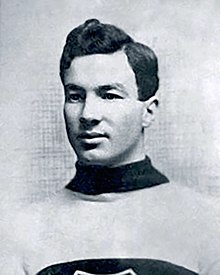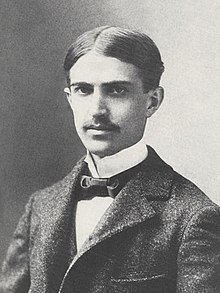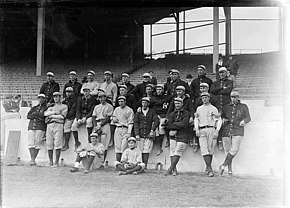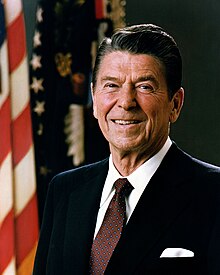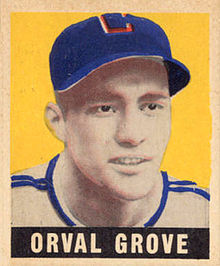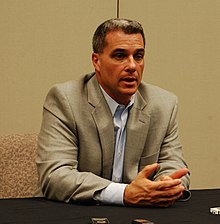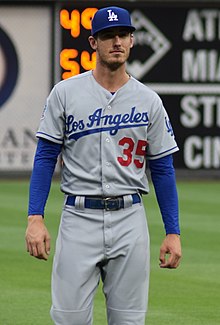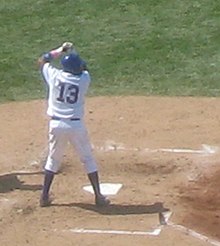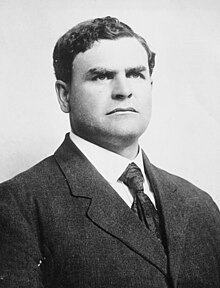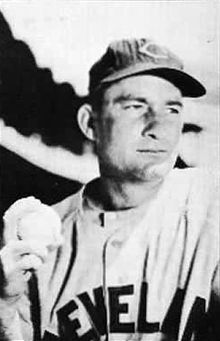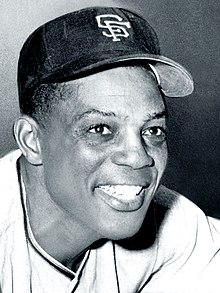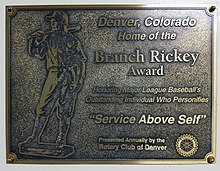| Main page | Content, Categories & Topics | WikiProjects & Things you can do |
The Baseball Portal
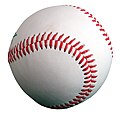
Baseball is a bat-and-ball sport played between two teams of nine players each, taking turns batting and fielding. The game occurs over the course of several plays, with each play generally beginning when a player on the fielding team, called the pitcher, throws a ball that a player on the batting team, called the batter, tries to hit with a bat. The objective of the offensive team (batting team) is to hit the ball into the field of play, away from the other team's players, allowing its players to run the bases, having them advance counter-clockwise around four bases to score what are called "runs". The objective of the defensive team (referred to as the fielding team) is to prevent batters from becoming runners, and to prevent runners' advance around the bases. A run is scored when a runner legally advances around the bases in order and touches home plate (the place where the player started as a batter).
The opposing teams switch back and forth between batting and fielding; the batting team's turn to bat is over once the fielding team records three outs. One turn batting for each team constitutes an inning. A game is usually composed of nine innings, and the team with the greater number of runs at the end of the game wins. Most games end after the ninth inning, but if scores are tied at that point, extra innings are usually played. Baseball has no game clock, though some competitions feature pace-of-play regulations such as the pitch clock to shorten game time.
Baseball evolved from older bat-and-ball games already being played in England by the mid-18th century. This game was brought by immigrants to North America, where the modern version developed. Baseball's American origins, as well as its reputation as a source of escapism during troubled points in American history such as the American Civil War and the Great Depression, have led the sport to receive the moniker of "America's Pastime"; since the late 19th century, it has been unofficially recognized as the national sport of the United States, though in modern times is considered less popular than other sports, such as American football. In addition to North America, baseball is considered the most popular sport in parts of Central and South America, the Caribbean, and East Asia, particularly in Japan, South Korea, and Taiwan. (Full article...)
General images -
Walter Emmons Alston (December 1, 1911 – October 1, 1984), nicknamed "Smokey", was an American baseball manager in Major League Baseball who managed the Brooklyn / Los Angeles Dodgers from 1954 through 1976, signing 23 one-year contracts with the team. Regarded as one of the greatest managers in baseball history, Alston was known for his calm, reticent demeanor, for which he was sometimes referred to as "the Quiet Man."
Born and raised in rural Ohio, Alston lettered in baseball and basketball at Miami University in Oxford. A journeyman whose MLB playing career consisted of only one game–two innings played, and one at-bat with the St. Louis Cardinals in 1936–Alston spent 19 years in the minor leagues as a player, player-manager and non-playing manager. His service included a stint as manager of the 1946 Nashua Dodgers, the first U.S.-based integrated professional team in modern baseball. After six successful seasons as manager of Brooklyn's Triple-A teams, the St. Paul Saints and Montreal Royals, Alston was promoted to manage the Dodgers in 1954. (Full article...)
Cody James Bellinger (born July 13, 1995) is an American professional baseball outfielder and first baseman for the Chicago Cubs of Major League Baseball (MLB). He has previously played in MLB for the Los Angeles Dodgers. He was selected by the Dodgers in the fourth round of the 2013 MLB draft and debuted with the team in 2017.
The son of MLB player Clay Bellinger, Bellinger helped his team reach the 2007 Little League World Series at the age of 11. He played high school baseball for Hamilton High School in Chandler, Arizona, and had committed to play college baseball for the Oregon Ducks before he was drafted. Bellinger spent two years in the Rookie Leagues before joining the Rancho Cucamonga Quakes in 2015, where he was a mid- and postseason all-star, and helped the team to a California League championship title. A hip injury delayed his rise through the Dodgers' farm system in 2016, but he was called up to the major leagues in April 2017 to bolster a struggling outfield. (Full article...)
Neifi Neftali Pérez (/ˈneɪfi, ˈnɛfi/; Spanish: [ˈnejfi]; born June 2, 1973) is a Dominican former Major League baseball player. He was a switch hitter who threw right-handed. During his career, he played with the Colorado Rockies, Kansas City Royals, San Francisco Giants, Chicago Cubs, and Detroit Tigers.
Pérez was originally signed by the Colorado Rockies in 1992. Frequently praised for his defensive skills, Pérez reached the major leagues in 1996 and became the Rockies' shortstop for good in 1997. Over the next three years, he scarcely missed a game and won a Gold Glove in 2000. In 2001, he was traded to the Kansas City Royals, where he also played in 2002. The trade proved to be unpopular with both teams, and Pérez joined the San Francisco Giants for 2003 and 2004. He lost his starting job during the 2004 season and was released during that year. Pérez then signed with the Chicago Cubs, whom he finished the season with and spent most of the next two years with. He was the Cubs' starting shortstop in 2005 but was used as a reserve player in 2006 before getting traded to the Detroit Tigers during the year. He finished his career in 2007 with the Tigers. As a Tiger, he turned a double play which saved Justin Verlander's no-hitter, but he also had a series of positive tests for amphetamines which effectively ended his career. (Full article...)
George Edward "Duffy" Lewis (April 18, 1888 – June 17, 1979) was an American professional baseball left fielder who played in Major League Baseball (MLB) for the Boston Red Sox, the New York Yankees, and the Washington Senators from 1910 to 1921.
Lewis attended Saint Mary's College of California. He made his MLB debut with the Red Sox in 1910, where he formed the Golden Outfield with Tris Speaker and Harry Hooper. He won three World Series championships with Boston (1912, 1915, and 1916). The Red Sox traded Lewis to the Yankees, where he played in 1919 and 1920, before they traded him to the Senators before the 1921 season. He continued to play and manage in the minor leagues until 1929. (Full article...)
Glenn Scobey Warner (April 5, 1871 – September 7, 1954), most commonly known as Pop Warner, was an American college football coach at various institutions who is responsible for several key aspects of the modern game. Included among his innovations are the single and double wing formations (precursors of the modern spread and shotgun formations), the three point stance and the body blocking technique. Fellow pioneer coach Amos Alonzo Stagg called Warner "one of the excellent creators". He was inducted as a coach into the College Football Hall of Fame as part of its inaugural class in 1951. He also contributed to a junior football program which became known as Pop Warner Little Scholars, a popular youth American football organization.
In the early 1900s, he created a premier football program at the Carlisle Indian Industrial School—a federally-funded, off-reservation Indian boarding school. He also coached teams to four national championships: Pittsburgh in 1915, 1916, and 1918 and Stanford in 1926. In all, he was head coach at the University of Georgia (1895–1896), Iowa Agricultural College and Model Farm (1895–1899), Cornell University (1897–1898 and 1904–1906), Carlisle (1899–1903 and 1907–1914), Pittsburgh (1915–1923), Stanford (1924–1932) and Temple University (1933–1938), compiling a career college football record of 319–106–32. Predating Bear Bryant, Eddie Robinson, and Joe Paterno, he once had the most wins of any coach in college football history. (Full article...)
Jay Justin "Nig" Clarke (December 15, 1882 – June 15, 1949) was a Canadian professional baseball player. A catcher, Clarke played in Major League Baseball (MLB) for nine seasons with the Detroit Tigers, Cleveland Naps, St. Louis Browns, Philadelphia Phillies, and Pittsburgh Pirates. In 506 career games, Clarke recorded a batting average of .254 and accumulated 20 triples, six home runs, and 127 runs batted in (RBI).
Born in Canada and raised in Michigan, Clarke began his baseball career in 1902, when he reportedly hit eight home runs in one game while playing for the Corsicana Oil Citys of the Texas League. From there, he spent two more seasons in the minor leagues before the Cleveland Naps signed him to a contract. Aside from a loan to the Detroit Tigers, he played for the Naps for six seasons. Clarke was then traded to the St. Louis Browns, where he played for one season. After several years in the minor leagues, Clarke joined the United States Marine Corps. He returned to the major leagues and played there until 1920, then continued playing for minor league teams until 1927. Clarke then retired from the game, rejoined the Marines, and moved to River Rouge, Michigan, where he lived until his death in 1949. (Full article...)
Robert Granville Lemon (September 22, 1920 – January 11, 2000) was an American right-handed pitcher and manager in Major League Baseball (MLB). Lemon was elected to the National Baseball Hall of Fame in 1976.
Lemon was raised in California where he played high school baseball and was the state player of the year in 1938. At the age of 17, Lemon began his professional baseball career in the Cleveland Indians organization, with whom he played for his entire professional career. Lemon was called up to Cleveland's major league team as a utility player in 1941. He then joined the United States Navy during World War II and returned to the Indians in 1946. That season was the first Lemon would play at the pitcher position. (Full article...)
After completing his collegiate career, Crisp began his long coaching career at the University of Alabama. There he served as the head basketball coach (1924–1942, 1945–1946), baseball coach (1928), track coach (1921–1927), as a line coach with the football team (1921–1941, 1945, 1950–1957) and as athletic director (1930–1940, 1954–1957). Crisp also served as an assistant and interim head coach with the Miami Seahawks (1946) and as a line coach at Tulane (1947–1949). (Full article...)
The Giants won the first game in an 8–0 shutout by starting pitcher Billy Pierce over Sandy Koufax. The Dodgers evened the series with an 8–7 victory in Game 2, breaking their 35-inning scoreless streak in what was then the longest nine-inning game in MLB history. However, the Giants closed out the series in Game 3 with a 6–4 victory to clinch the NL pennant. This victory advanced the Giants to the 1962 World Series in which the defending champion New York Yankees defeated them in seven games. In baseball statistics, the tie-breaker series counted as the 163rd, 164th, and 165th regular season games for both teams, with all events in the series added to regular season statistics. (Full article...)
Did you know (auto-generated) -

- ... that Corky Palmer coached the Southern Miss Golden Eagles to their only College World Series appearance in 2009?
- ... that Amanda Asay was the longest-serving member of the Canadian women's baseball team when she died at 33, having played on the team for sixteen years?
- ... that after he retired from professional baseball, Paul Hinrichs became a Lutheran minister?
- ... that under a rules draft presented at the 1857 baseball convention, baseball bats would have been allowed to be shaved flat on one side?
- ... that Milt Wilcox, winning pitcher of Game 3 of the 1984 World Series, credited "throwing bowling balls" with rescuing his Major League Baseball career?
- ... that Tyler Gilbert threw a no-hitter in his first Major League Baseball start?
- ... that baseball player Eric Filia worked as a butler at the Playboy Mansion while he was suspended by the University of California, Los Angeles?
- ... that Barack Obama was once gifted a baseball glove belonging to Tampa Bay Rays pitcher Matt Moore?
Quotes
More did you know
- ... that Dock Ellis pitched a no-hitter while under the influence of LSD?
- ... that Lorinda de Roulet is the first woman to direct the day-to-day operations of a Major League Baseball franchise?
- ... that Max Kepler-Rozycki received the largest signing bonus given to a European player by a Major League Baseball team?
- ... that Andrew Heaney led all college baseball pitchers in strikeouts during the 2012 season?
- ... that Johnny Evers alerted an umpire to Merkle's Boner?
Sports portals
Selected picture
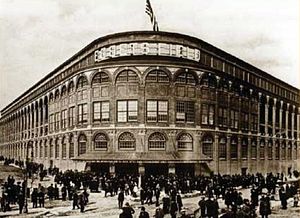
Ebbets Field was a Major League Baseball park located in the Flatbush section of Brooklyn, New York. It was the home of the Brooklyn Dodgers of the National League. Two different incarnations of a Brooklyn Dodgers football team also played at the stadium. The park opened on April 9, 1913, and was demolished in 1960, three years after the team relocated to Los Angeles.
Associated Wikimedia
The following Wikimedia Foundation sister projects provide more on this subject:
-
Commons
Free media repository -
Wikibooks
Free textbooks and manuals -
Wikidata
Free knowledge base -
Wikinews
Free-content news -
Wikiquote
Collection of quotations -
Wikisource
Free-content library -
Wikiversity
Free learning tools -
Wiktionary
Dictionary and thesaurus



